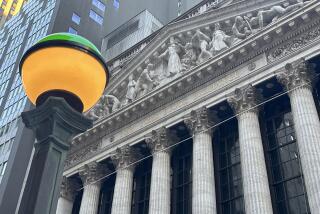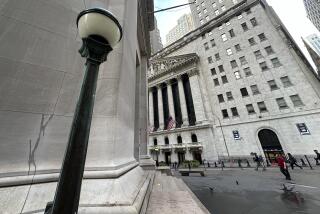A Healthy Start
The stock market once again made lemonade out of lemons, as Wall Street turned its back on worries about global economic turmoil and racked up another terrific quarter.
With one day left to go in the first quarter, the Dow Jones industrial average has gained 11.1% year-to-date to 8,782.12, though it has slipped from its record high of 8,906.43 reached March 20.
The U.S. market’s advance has been broad-based, with most major indexes rising between 9% and 13%, led once again by big-name stocks. The average domestic stock mutual fund earned 10.4% in the quarter through last Friday, according to fund tracker Morningstar Inc.
The rest of the world has been along for the equity ride as well. European stock markets, in fact, have far outpaced the U.S. market’s gain this year. And even most Asian markets bounced from their multiyear lows reached in mid-January, amid the region’s deep economic crisis.
Asia, of course, was Wall Street’s great fear at the beginning of the quarter. With the region’s currencies and financial markets in shambles after investors fled the troubled economies of South Korea, Thailand, Indonesia and others last year, the widespread assumption was that the global economy would quickly be dragged down as well--threatening the corporate earnings that have underpinned stocks.
But in the United States, Asia turned out to be more friend than foe for the market overall, by keeping the Federal Reserve Board--which had been hinting last fall at the need to tighten credit--on hold. (The Fed meets today and is widely expected to again leave interest rates alone.)
Meanwhile, surprising strength in the domestic economy buoyed the stock market, as it became clear that consumer confidence, and spending, remained robust.
A warm winter in much of the country also helped by keeping home sales cooking and by depressing energy demand--which led to a crash in oil prices, to nine-year lows, in recent weeks. That, in effect, provided a tax cut for the U.S. economy, and also helped subdue inflation.
In Europe, the markets’ gains also were stoked by home-grown economic strength that offset much of the drag from Asia’s woes, and by a continuing decline in interest rates tied to the Continent’s planned monetary union Jan 1.
Still, for all the good news, analysts noted that plenty of U.S. multinational companies have already warned that Asia’s problems finally are coming home to roost in the form of weaker sales and earnings.
Indeed, earnings growth of blue-chip U.S. companies overall is expected to be less than 1% this quarter.
Wall Street’s bears ask how investors can justify the market’s gains given those expectations--especially with blue-chip stocks’ price-to-earnings ratios at historically high levels.
Even those analysts who are long-term bulls say the market is overdue for a pullback. “You don’t need too much to go wrong to get a correction here,” warned Roy Blumberg, investment strategist at Josephthal Lyon & Ross in New York.
He expects major indexes to fall 5% to 10% in the second quarter. The trigger could be first-quarter earnings reports, he said, if they are weaker even than expected.
But Peter Canelo, strategist at Morgan Stanley, Dean Witter, Discover & Co. in New York, argues that “expectations are so low now [for blue-chip earnings] that they’re going to be really easy to beat.”
What’s more, he notes that many small and mid-sized companies that are mostly dependent on the domestic economy should report decent earnings growth.
Many analysts say the powerful continuing appeal of stocks to investors--not just in the United States, but increasingly in Europe as well--is largely rooted in the sense that there simply is no better alternative investment.
So long as interest rates and inflation remain tame, and money in general is easy, large and small investors alike are likely to find more reasons to be in the stock market than out of it, analysts say.
(BEGIN TEXT OF INFOBOX / INFOGRAPHIC)
For Stocks, the Beat Goes on . . . and on
After a rough start to the first quarter, the Dow Jones industrial average quickly returned to doing what it does best--climbing. The Dow, at 8,782.12 on Monday, is up 873.87 points, or 11.1%, so far this year and has paced a broad market advance that has carried most U.S. stock indexes to record highs amid a healthy U.S. economy and stable interest rates.
The Dow
Monday: 8,782.12
April 1995: 4,321.27
*
Most U.S. Indexes Rise . . .
Price change, year-to-date
Nasdaq composite: 15.8%
S&P; 500: 12.7
Wilshire 5,000: 12.1
NYSE composite: 11.3
Dow industrials: 11.1
S&P; mid-cap: 9.8
S&P; small-cap: 9.6
Russell 2,000: 9.0
Dow transports: 7.5
Dow utilities: 3.2
*
. . .as Bond Yields Hold Steady . . .
30-year Treasury bond yield, weekly closes and latest:
Monday: 5.97%
*
. . .and the Bulls Romp Worldwide
Price changes in major world stock markets, year-to-date:
Italy: +39%
France: +27
Germany: +20
Britain: +15
Brazil: +15
Canada: +13
Japan: +7
Hong Kong: +7
Australia: +5
Mexico: --4 Source: Bloomberg News
Quarterly Review Today’s Wall Street, California pages include analysis, tables and other tools to help you evaluate your portfolio, including:
* What’s ahead for Wall Street and the foreign markets. D5-8
* A package of stories and insight on mutual funds. D11-12
* Three pages of Morningstar’s top-rated mutual funds, plus data on 4,000 U.S. funds. D13
More to Read
Inside the business of entertainment
The Wide Shot brings you news, analysis and insights on everything from streaming wars to production — and what it all means for the future.
You may occasionally receive promotional content from the Los Angeles Times.










